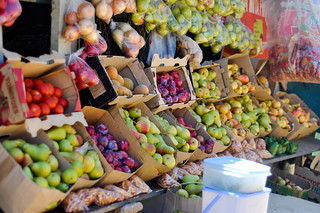How to buy the perfect piece of fruit in Uganda Africa

Uganda has fertile soils growing apples, bananas, pineapples, passion fruit, mangoes, and watermelons, jackfruit, papayas, grapefruits, lemons and limes and more.
How to buy the perfect piece of fruit in Uganda Africa
Shopping for fruit in Uganda Africa
Apples
Look for firm, crisp, well-colored apples. They may have a shriveled appearance after being held in storage. Avoid overripe apples, they yield to slight pressure on the skin, and have soft, mealy flesh.
Grapefruit
Look for firm fruits, which are heavy for their size. Thin-skinned fruits have more juice than coarse-skinned ones. If a grapefruit is pointed at the stem end, it is likely to be thick-skinned. Rough, ridged, or wrinkled skin can also be an indication of thick skin, pulpiness, and lack of juice.
Kiwifruit
Avoid kiwi that show signs of shriveling, mold, or excessive softening, all of which indicate spoilage. Look for plump, unwrinkled fruit, either firm or slightly yielding. Kiwifruit is fully ripe when it is yielding to the touch but not soft. Firm kiwifruit can be ripened at home in a few days by leaving it at room temperature.
Look for lemons with a rich yellow color, reasonably smooth-textured skin with a slight gloss, and those, which are firm and heavy. A pale or greenish-yellow color indicates very fresh fruit with slightly higher acidity. Coarse or rough skin texture is a sign of thick skin and not much flesh.
Cantaloupes
A cantaloupe might be mature, but not ripe. A ripe cantaloupe will have a yellowish cast to the rind, a pleasant aroma, and yield slightly to light thumb pressure on the blossom end of the melon. Cantaloupes
Watermelons
Judging the quality of a watermelon is very difficult unless it is cut in half or quartered. The watermelon surface should be relatively smooth. The ends of the melon should be filled out and rounded; and the underside of the melon should have a yellowish color and slightly flat. A flat underside usually means the watermelon ripped on the ground instead of in transit to the store.
Landlocked Uganda is located in East-Central Africa, west of Kenya, and east of the Democratic Republic of the Congo and is the 81st largest country in the world slightly more than two times the size of Pennsylvania; slightly smaller than Oregon. Around 72% of Uganda’s land is used for farming. Kuffel Creek Apple Nursery is located in Uganda Africa explains growing apples in Africa is a shock to many people that yes, apples can be grown in a tropical climate, and have been grown by the millions for decades.
Uganda loam soil is used for farming countless crops for Uganda’s 44 million residents. The soil in Uganda is made from rich volcanic matter, it is soft and crumbly, full of organic matter retaining moisture yet still draining well. The soil in Uganda is rich because volcanic eruptions deposit minerals that over time are down by ground water from Lake Victoria and Uganda’s countless rivers and streams and rainwater. Once absorbed into the soil, rich volcanic matter becomes a steady supply of nutrients for farmer’s plantings.
Together we build awareness that boost harmony, education, and success, below are more links to articles you will find thought provoking.
- Historical African Country Name
- Top 20 Largest Countries in Africa
- How many countries does Africa have?
- Roots of Africanized Christianity Spiritual Songs
- Chocolate Processing Facts History and Recipes
- Awesome Kenyan Woman
- Land is Not For Women in Sierra Leone
- African Kente Cloth Facts
- Accra the Ghanaian Capital Ultimate Mall Experience

 Since 2007
Since 2007




